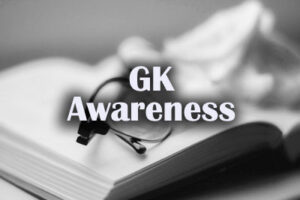Selected Questions on General Awareness for all Competitive Exam
Interested users can download the Selected Questions on General Awareness from the links enclosed below. Download the Last 5 Years Selected Questions on General Awareness Solved along with the Answers of each question.

This Selected Questions on General Awareness may vary from the Actual paper. Use the Selected Questions on General Awareness as a reference for the exam preparation. Check the Selected Questions on General Awareness from this page.
At the bottom of this page, you will find ‘Click here links’ for downloading the Selected Questions on General Awareness. Click on the required link & download your related Selected Questions on General Awareness to make as a reference for your scheduled preparation.
General Studies Selected Questions
1. West Indies is also called
(a) Sugar Bowl of the World
(b) Islands of Sunshine
(c) The Spice Island of the West
(d) Pearl of Antilles
2. International Day of Families is observed on
(a) 15th February
(b) 15th March
(c) 15th April
(d) 15th May
3. Vijay Diwas is observed in India on every 16th December to commemorate
(a) Indo-Pakistan War of 1947
(b) Indo-Pakistan War of 1965
(c) Indo-Pakistan War of 1971
(d) Indo-Pakistan War of 1999
4. National Statistics Day is observed every year in India on 29th June to commemorate the birth anniversary of
(a) P.C.Mahalanobis
(b) D.R.Gadgil
(c) V.K.R.V.Rao
(d) Suresh D.Tendulkar
5. ‘White Label ATM (WLAs)’ means
(a) ATM installed in Bank branches
(b) ATM installed outside bank branches
(c) ATM installed at the point of sale
(d) ATM installed by non-banking companies
6. The new name of Insurance Regulatory and Development Authority (IRDA) is
(a) Insurance Regulatory and Development Agency (IRDA)
(b) Insurance Regulatory and Development Authority of India (IRDAI)
(c) Insurance Regulatory and Research Development (IRD)
(d) Insurance Regulatory and Research Wing of India (IRWAI)
7. Who is the first vice-chairman of NITI-Aayog?
(a) Bibek Debroy
(b) Alur Seelin Kiran Kumar
(c) VK. Saraswat
(d) Arvind Panagariya
8. Writer of the book, ‘To A Hunger Free World’
(a) Prof. Amartya Sen
(b) Dr. A.P.J.Abdul Kalam
(c) M.S.Swaminathan
(d) Ranghuram Rajan
9. The author of the controversial book, ‘The Hindus: An alternative history’ is
(a) Dan Brown
(b) Peter Senge
(c) V.S.Naipaul
(d) Wendy Doniger
10. “Government can be changed not by bullet, but by ballot”. Who said this?
(a) Karl Marx
(b) George Washington
(c) Nelson Mandela
(d) Mahatma Gandhi
11. What is the full form of MFN?
(a) Money From North
(b) Most Favoured Nation
(c) Multi-Front Navy
(d) Monetary Fund Nexus
12. Full form of NEXRAD
(a) Next Rapid Development
(b) New X-Ray Developer
(c) Next Generation Radar
(d) Neo-X-Ray Developer
13. What does UNRRA stand for?
(a) United Nations Rehabilitation and Relief Administration
(b) United Nations Relief and Rehabilitation Agency
(c) United Nations Rehabilitation and Relief Agency
(d) United Nations Relief and Rehabilitation Administration
14. What is the full form of SDRs?
(a) Software Define Radio
(b) Simple Divide Rules
(c) Sub-Divisional Registrars
(d) Special Drawing Rights
15. The city commonly known as ‘Manchester of India’
(a) Kolkata
(b) Jaipur
(c) Ahmedabad
(d) Ladakh
16. Which country is famously known as ‘Lady of Snow’?
(a) Russia
(b) Canada
(c) Netherlands
(d) Norway
17. A country also known as ‘Land of White Elephants’
(a) Malaysia
(b) Cambodia
(c) Thailand
(d) Vietnam
18. Inventor of ‘Printing Press’
(a) John Guttenberg
(b) Christian Bernard
(c) John Carbutt
(d) Zacharis Janssen
19. Dada Saheb Phalke Award is given for outstanding contribution in the field of
(a) Music
(b) Cinema
(c) Literature
(d) Dance
20. The financial year for banks is April-March but what is the financial year for RBI?
(a) April – March
(b) October – September
(c) July – June
(d) January – December
21. ‘World AIDS Day’ is observed every year on
(a) December 1
(b) December 7
(c) November 21
(d) November 3
22. NITI Aayog, a new avatar of the grand old Planning Commission was established on
(a) January 1, 2015
(b) December 1, 2014
(c) February 15, 2015
(d) March 15, 2015
23. Name the then Indian ruler when East India Company was set up
(a) Jehangir
(b) Akbar
(c) Humayun
(d) Aurangzeb
24. The Island of Bombay was given to the English Prince Charles II as dowry by the
(a) Danish
(b) Dutch
(c) Portuguese
(d) English
25. With whose permission did the English set up their first factory in Surat?
(a) Akbar
(b) Jahangir
(c) Shahjahan
(d) Aurangzeb
More Question Set on General Studies
| Model Question | Old Question |
| Sample Papers | Mock Test |
| Practice Set | Question Bank |
| Important Questions | Test Papers |
| Typical Questions | Selected Questions |
26. The East India Company opened its first Mint in India in 1757 at
(a) Bombay
(b) Surat
(c) Calcutta
(d) Delhi
27. During the reign of which Governor General the treasury had been shifted from Murshidabad to Kolkata?
(a) Warren Hastings
(b) Lord Cornwallis
(c) Lord Ripon
(d) Lord Wellesley
28. The historic ‘Black Hole Tragedy’ took place on
(a) June 16, 1756
(b) January 23, 1757
(c) July 17, 1756
(d) June 20, 1756
29. What was the reason or ground for the British Empire to annex Sambalpur in 1850?
(a) Lack of proper governance
(b) Death of its ruler without any heir
(c) Subsidiary Alliance
(d) Its involvement in a conspiracy against British Rule
30. Cornwallis Code deals with
(a) Administrative reforms
(b) Laws
(c) Revenue measures
(d) Education measures
31. The Indian states that were annexed by invoking the Doctrine of Lapse included
(a) Jhansi, Nagpur and Travancore
(b) Jhansi, Nagpur and Satara
(c) Mysore, Satara and Bhavnagar
(d) Jhansi, Awadh and Bengal
32. Who among the following is known as ‘the liberator of the press’?
(a) William Jones
(b) Wellesley
(c) Sir Charles Metcalfe
(d) Lord Minto
33. Which Act is called Pitt’s India Act?
(a) East India Company Act, 1784
(b) East India Company Act, 1773
(c) Act of 1786
(d) Charter Act of 1813
34. The Permanent Settlement Act of 1793 was formulated by the then Governor General of India,
(a) Lord Cornwallis
(b) Lord Wellesley
(c) Warren Hastings
(d) Lord Dalhousie
35. The significance of the Bengal Regulation of 1793 lies in the fact that—
(a) It provided for the establishment of the Supreme Court
(b) It restricted the application of English law to Englishmen only
(c) It accommodated the personal laws of Hindus and Muslims
(d) It provided for the appointment of the Indian Law Commission
36. With whom was the permanent settlement made?
(a) With peasants, cultivators
(b) With the Muqaddams
(c) With the Zamindars
(d) With village communities
37. Lord Cornwallis reduced the number of districts of Bengal province from 36 to
(a) 21
(b) 23
(c) 24
(d) 30
38. Who put an end to the system of Dual Government in Bengal?
(a) Warren Hastings
(b) Clive
(c) Regulating Act
(d) British Parliament
39. The Ryotwari system associated with the name of Sir Thomas Munro, who was appointed
(a) Governor General of India
(b) Governor of Bengal
(c) Governor of Madras
(d) Governor General of Bengal
40. The monopoly of East India Company over the trade of India was abolished by
(a) Charter Act of 1813
(b) Charter Act of 1833
(c) Charter Act of 1853
(d) Regulating Act
41. The demand for the creation of Department of Agriculture under the Government of India came from
(a) East India Company
(b) British Government
(c) Office of the Governor-General
(d) Manchester Cotton Supply Association
42. The Battle of Plassey was considered as one of the most decisive battles of India because
(a) Great feats of valour were shown by the opposing force
(b) It made the English master of Bengal and overran the whole India within the next hundred years
(c) Robert Clive, for the first time showed his military stratagem
(d) The French in India were decicively beaten
43. The Uprising of 1857 was described as the first Indian war of Independence by
(a) SN Sen
(b) RC Mazumdar
(c) BG Tilak
(d) VD Savakar
44. The most important aspect in Queen Victoria’s Proclamation was
(a) The administration in India was taken over by the Crown
(b) Property qualification were prescribed for franchise
(c) The Governor of Bengal came to be called as Governor-General
(d) Provincial autonomy was accorded
45. The first Governor General of Free India was
(a) Lord Wavell
(b) Lord Mountbatten
(c) C.Rajagopalalchari
(d) Sir John Shore
46. Which Proclamation was called the ‘Magna Carta of Indian Liberty’?
(a) Abolition of Doctrine of Lapse
(b) Widow Remarriage Act
(c) Royal Proclamation on partition of Bengal in 1905
(d) Queen’s Proclamation of 1858
47. Name the first newspaper which was published in India.
(a) The Bengal Gazette
(b) The Calcutta Chronicle
(c) The Calcutta Gazette
(d) The Oriental Magazine of Calcutta
48. Which Governor-General introduced the Civil Services for the first time in India?
(a) Warren Hastings
(b) Lord Wellesley
(c) Lord Cornwallis
(d) Lord Dalhousie
49. The controversial Gilbert Bill of 1883 was during the administration of
(a) Lord Curzon
(b) Lord Lytton
(c) Lord Ripon
(d) Lord Reading
50. The only Indian prince who actively participated in the Revolutionary Movement within and outside India was—
(a) Raja Aridaman Singh
(b) Raja Hari Singh
(c) Raja Kumar Singh
(d) Raja Mahendra Pratap


